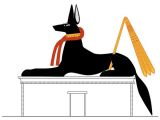New molecular evidence uncovered by biologists from the University of Oslo, Oxford University's Wildlife Conservation Research Unit (WildCRU) and Addis Ababa University, has revealed that the Egyptian jackal is not a subspecies of the golden jackal, but rather a new species of gray wolf.
The new African wolf was confused with golden jackals and believed to be an Egyptian subspecies of jackal, but it looks like 3 million years ago, members of the gray wolf reached Africa – before they spread throughout the northern hemisphere.
This is not the first time that someone has doubts about the origins of the Egyptian jackal, because in 1880, the great evolutionary biologist Thomas Huxley, said that this animal looked very much like the gray wolf.
Twentieth century biologists studying skulls made the same observations but this did not change anything about the classification of the species.
Today, things are a bit different since scientists benefit from the latest genetic techniques, so they were finally able to confirm the true belonging of the Egyptian jackal to the gray wolf species complex.
The new study concluded that it is not a jackal, but a wolf, part of the same family as the Holarctic gray wolf, the Indian wolf and the Himalayan wolf.
Genetics say that the Indian and the Himalayan wolves evolved separately from the modern wolf cluster, even before the gray wolf reached the northern hemisphere.
Moreover, the wolfish colonization of Africa took place even before the gray wolf spread at all.
“We could hardly believe our own eyes when we found wolf DNA that did not match anything in GenBank,” said Dr Eli Rueness, the first author of the paper.
The African continent was colonized by the ancestral stock of gray wolves nearly 3 million years ago, and is today incarnated by an animal called the Egyptian jackal.
The IUCN (International Union for Conservation of Nature), classified the golden jackals as not endangered, “species of least concern”, but the newly discovered African wolf could be much rarer, so it is a priority for conservation and science to find out more about its numbers and whereabouts.
The research team also found genetically very similar specimens at 2,500 km from Egypt, in Ethiopia, and professor Claudio Sillero, of the WildCRU and current Chairman of the IUCN's Canid Specialist Group, explained that “Ethiopian wolves split off from the gray wolf complex even earlier than the newly discovered African wolf.”
“A wolf in Africa is not only important conservation news, but raises fascinating biological questions about how the new African wolf evolved and lived alongside not only the real golden jackals but also the vanishingly rare Ethiopian wolf, which is a very different species with which the new discovery should not be confused,” remarked professor David Macdonald, an author of the paper and Director of Oxford's WildCRU.
So now, the Egyptian jackal should probably change its name, since not only it is not a jackal, but it's the only member of the gray wolf complex in Africa, the real African wolf.
This research has been published in PLoS ONE.

 14 DAY TRIAL //
14 DAY TRIAL // 

